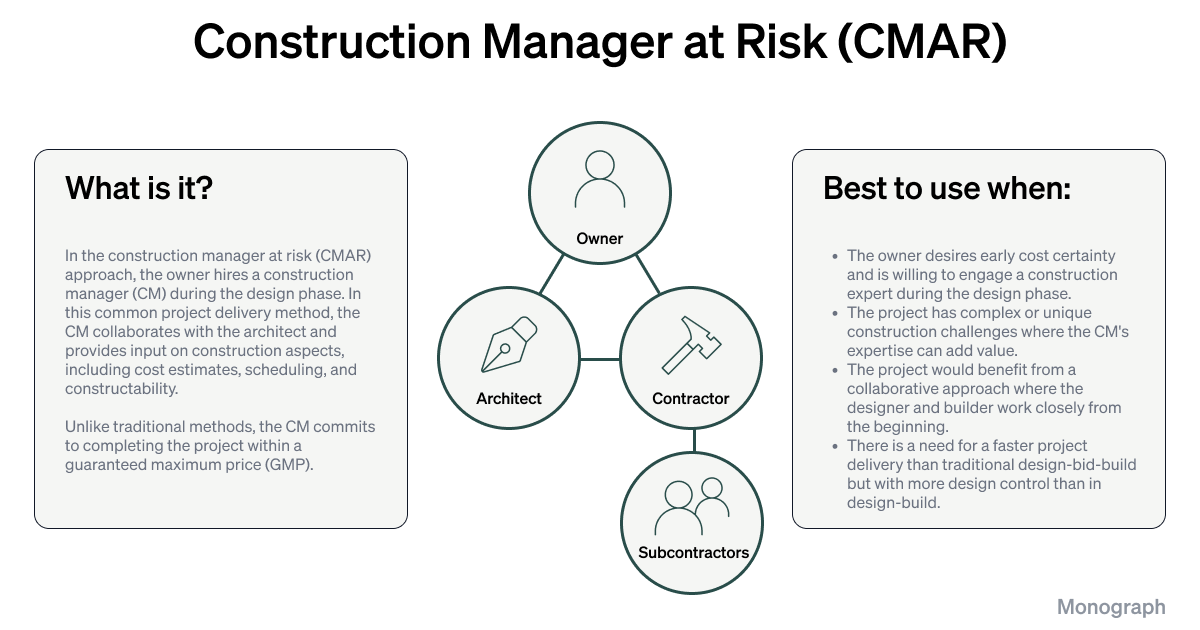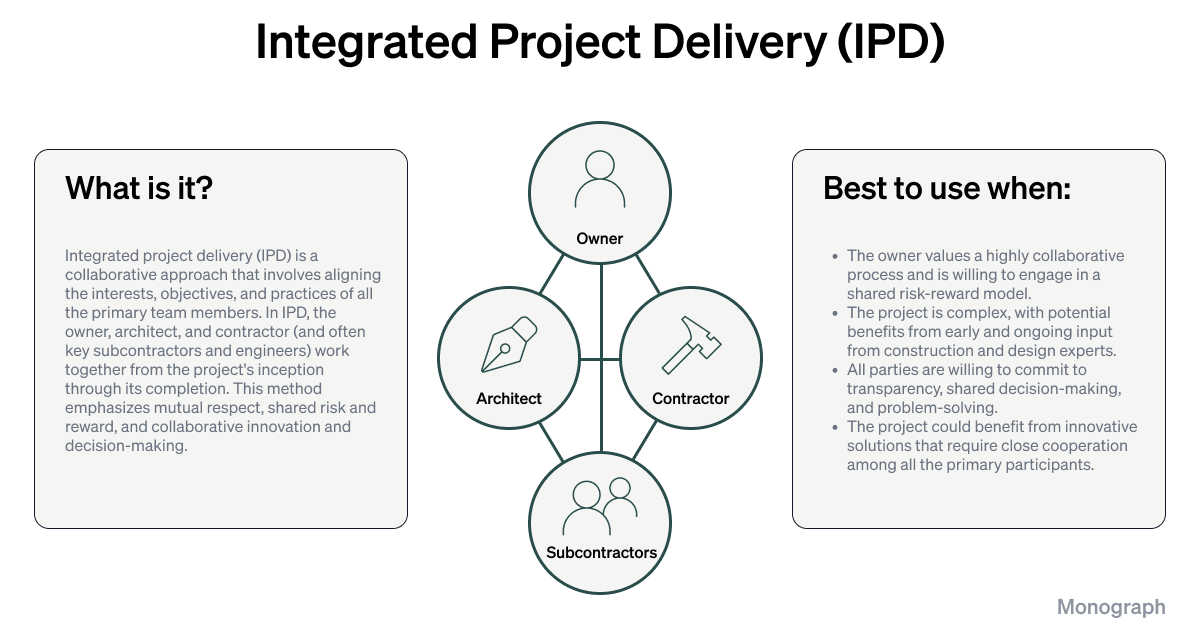Contents
There’s more than one right way to complete a construction project, but each project delivery method has its strengths and weaknesses, and some are better for architects than others.
For example, a project owner can choose for design and construction to be handled by a single firm on one contract, or they can go the “traditional” route and hire an architect to complete the designs before opening the project for construction bids.
These are known as design-build (DB) and design-bid-build (DBB), and they’re just two of the most popular project delivery methods today. Others include construction manager at risk (CMAR), construction manager multi-prime (CMMP), integrated project delivery (IPD), and public-private partnership (PPP) — each with unique project phases and contract structures.
When selecting the best project delivery method, owners must consider the design of the project as well as the limitations, such as budget, schedule, experience level of the parties involved, and the unique risks of the project.
In this article, we’ll examine 6 of the best project delivery methods for architects, and we’ll detail the benefits and drawbacks of each.
6 construction project delivery methods for architects
A project delivery method defines the unique process through which a construction or renovation project becomes a reality — from the design phase to locking the front door. It also specifies the responsibilities of various parties and stakeholders, such as the owner, designer, and contractor.
Here are the 6 best project delivery methods for architects.
1. Design-Build (DB)
In the design-build project delivery method, a single entity (the design-builder) is responsible for both designing and constructing the entire project. This entity could be a single firm, a consortium, or a joint venture. The client engages this entity through a single contract, and the design-builder manages all subcontractors, also known as trade contractors, and consultants.

Advantages
- Single point of responsibility: Simplifies communication and decision-making, reducing the client's coordination efforts.
- Time and cost efficiency: Often leads to faster completion and potentially lower project costs, as design and construction phases can overlap.
- Enhanced communication: Better coordination between the design team and the construction team can lead to more efficient and effective solutions.
- Reduced risk for owner: The design-builder assumes more of the risk, as they are responsible for delivering the building project within the agreed time and budget.
Disadvantages
- Less design control: The client may have less direct control over the design process compared to traditional methods.
- Potential for lower quality: If the design-builder prioritizes cost and schedule over quality, there could be compromises in design excellence.
- Limited competitive bidding: The selection of contractors and subcontractors is not based on competitive bidding, which might lead to higher construction costs.
- Fewer checks and balances: The consolidation of roles can lead to fewer checks and balances in the process.
When should an architect use the design-build method?
An architect should consider the design-build method when:
- The client prefers a single point of responsibility for both design and construction.
- The project has a tight schedule, requiring fast-track construction.
- The project scope is well-defined, minimizing the need for extensive design changes.
- The client is comfortable with less involvement in the design and construction process and is more focused on the outcome.
Design-build is particularly suitable for projects where speed and budget are critical and where the client trusts the design-builder to make decisions that best balance cost, time, and quality.
2. Design-Bid-Build (DBB)
Design-bid-build is the traditional project delivery method in the construction industry. It involves three distinct phases:
- Design phase: The owner contracts with an architect or engineering firm to design the project.
- Bidding phase: After the design is complete, contractors bid on the construction contract. The owner reviews these bids.
- Build phase: The owner then selects a contractor based on the bids, and construction begins.
Each phase occurs sequentially, and the owner holds separate contracts for design and construction services.

Advantages
- Quality of design: Allows for a detailed and thorough design process, potentially leading to higher-quality design outcomes.
- Competitive bidding: Construction bids are competitive, which can lead to lower construction costs.
- Clear roles and responsibilities: Well-established roles and separation between design and construction tasks.
- Owner control: The owner has significant control over the design process and selection of the construction contractor.
Disadvantages
- Longer project duration: Sequential phases can extend the overall project timeline.
- Potential for higher costs: Changes during the construction phase can be costly since they were not part of the original design.
- Risk of adversarial relationships: Potential for conflict between the designer and contractor, as they have separate contracts with the owner.
- Increased owner involvement: Requires more involvement and coordination effort from the owner.
When should an architect use the design-bid-build method?
This construction procurement method is most appropriate when:
- The project scope is well-defined and unlikely to change.
- The owner wants to ensure a high-quality design and is willing to invest time in the design phase.
- Competitive pricing for construction is a priority.
- The owner prefers clear separation of design and construction responsibilities.
DBB is ideal for projects where the owner values design quality over speed of delivery and is comfortable managing multiple contracts and the inherent separation between design and construction phases. It is a good choice for projects with a clearly defined scope and where change orders during construction are unlikely.
3. Construction Manager at Risk (CMAR)
In the construction manager at risk (CMAR) approach, the owner hires a construction manager (CM) during the design phase. In this common project delivery method, the CM collaborates with the architect and provides input on construction aspects, including cost estimates, scheduling, and constructability.
Unlike traditional methods, the CM commits to completing the project within a guaranteed maximum price (GMP). Once the design is sufficiently developed, the CM acts as the general contractor, bearing the risk of meeting the GMP.

Advantages
- Early involvement of CM: The CM's early involvement can lead to more accurate cost estimations and better integration of construction knowledge into the design.
- Cost control: The GMP provides a cost ceiling, reducing the owner's risk of budget overruns.
- Collaborative approach: Facilitates teamwork and collaboration between the architect and CM, potentially improving project outcomes.
- Flexibility in construction: Allows for some construction work to begin before the entire design is complete, which can shorten the overall project timeline.
Disadvantages
- Potential for reduced bid competition: Since the CM is selected early, some of the construction work may not go through competitive bidding.
- Risk of higher costs: If the GMP is set too high, the owner might end up paying more than in a competitive bid scenario.
- Dependence on CM's expertise: The project's success heavily relies on the CM's skills and experience.
- Possible conflicts of interest: The CM may prioritize cost-saving measures over design quality or long-term durability.
When should an architect use the construction manager at risk method?
The construction manager at risk method is suitable when:
- The owner desires early cost certainty and is willing to engage a construction expert during the design phase.
- The project has complex or unique construction challenges where the CM's expertise can add value.
- The project would benefit from a collaborative approach where the designer and builder work closely from the beginning.
- There is a need for a faster project delivery than traditional design-bid-build but with more design control than in design-build.
CMAR is particularly effective for complex projects where the owner values the input of a construction expert pre-construction, during the project design phase, and is willing to trade some potential cost savings from competitive bidding for the benefit of cost certainty and collaborative project development.
4. Integrated Project Delivery (IPD)
Integrated project delivery (IPD) is a collaborative approach that involves aligning the interests, objectives, and practices of all the primary team members. In IPD, the owner, architect, and contractor (and often key subcontractors and engineers) work together from the project's inception through its completion. This method emphasizes mutual respect, shared risk and reward, and collaborative innovation and decision-making.
Contracts in IPD often include incentives for meeting project goals and penalties for failing to meet them, with all key parties sharing in the risks and rewards.

Advantages
- High level of collaboration: Encourages all parties to work closely together, fostering innovation and efficiency.
- Shared risk and reward: Aligns the interests of all parties, as everyone shares in the success or failure of the project.
- Early identification of problems: Collaborative approach helps in early identification and resolution of design and construction issues.
- Optimization of results: Focuses on achieving the best possible outcome for the project as a whole, not just individual goals.
Disadvantages
- Complexity in contracts and relationships: Requires complex legal agreements to manage the shared risks and rewards.
- Need for trust and willingness to collaborate: Depends heavily on the willingness of all parties to work closely and transparently.
- Potential for reduced competitive bidding: Some aspects of the project may not go through traditional competitive bidding processes.
- Requires experienced participants: Effective IPD relies on parties experienced in collaborative work and comfortable with a high degree of integration.
When should an architect use the integrated project delivery method?
An architect should consider IPD in scenarios where:
- The owner values a highly collaborative process and is willing to engage in a shared risk-reward model.
- The project is complex, with potential benefits from early and ongoing input from construction and design experts.
- All parties are willing to commit to transparency, shared decision-making, and problem-solving.
- The project could benefit from innovative solutions that require close cooperation among all the primary participants.
IPD is ideal for complex, innovative projects where the owner and project team are willing to engage in a highly collaborative process. This approach is most effective when all parties are committed to the principles of mutual respect, shared goals, and open communication.
5. Public-Private Partnership (P3)
Public-private partnerships (P3s) involve collaboration between a government entity and one or more private sector companies. In this model, the private sector typically finances, designs, builds, and sometimes operates a public facility or service.
In return, the private entity may receive payment from the public sector and/or revenue generated from the project. The specifics of the arrangement can vary greatly depending on the project and the agreement terms.

Advantages
- Leveraging private sector expertise and efficiency: Brings in private sector innovation and operational efficiencies.
- Risk sharing: Risks are shared between the public and private sectors, often leading to better risk management.
- Financial flexibility: Allows for large-scale projects to proceed without immediate public expenditure, as the private sector provides upfront financing.
- Quality and lifecycle focus: The private sector's involvement in operations and maintenance can ensure a focus on the long-term quality and sustainability of the project.
Disadvantages
- Complex negotiations and contracts: Establishing a P3 arrangement can be time-consuming and complex.
- Potential for higher long-term costs: The private sector's need for profit can mean higher costs over the lifespan of the project compared to traditional public project financing.
- Public accountability and transparency issues: Balancing public and private interests can be challenging, with concerns about transparency and accountability.
- Reduced control for the public sector: The public entity may have less control over the project's aspects, depending on the contract terms.
When should an architect use the public-private partnership method?
Architects should consider a P3 arrangement when:
- The project is large-scale, such as infrastructure or public facilities, and requires significant investment that the public sector cannot readily provide.
- There is a potential for the project to generate revenue (like toll roads, public housing, or hospitals).
- The project would benefit from the innovation, efficiency, and expertise of the private sector.
- There is a willingness from both public and private sectors to engage in a long-term partnership.
P3s are particularly suitable for large, complex projects where upfront public funding is limited, and there is an opportunity to harness private sector efficiencies and investment. These projects often involve significant community benefits, such as transportation infrastructure, healthcare facilities, and educational institutions.
6. Construction Manager Multi-Prime (CMMP)
In the construction manager multi-prime (CMMP) approach, the owner retains more control over the construction process by contracting directly with multiple prime contractors (or "primes") for different aspects of the work (like electrical, plumbing, structural).
A construction manager is hired to act as an advisor and coordinator, managing the various prime contracts and ensuring that the work is completed in an integrated and efficient manner. The CM does not perform the construction work but rather provides oversight and expertise.

Advantages
- Owner control: The owner has direct control over each aspect of the construction, as they hold separate contracts with each prime contractor.
- Potential for cost savings: Direct contracting with primes can lead to competitive pricing and potential cost savings.
- Flexibility in contractor selection: The owner can select specialized contractors for different components of the project.
- Expert oversight: The CM provides expertise in coordinating the various trades, which can enhance project efficiency and quality.
Disadvantages
- Complex coordination: Managing multiple prime contracts can be complex and requires diligent coordination and oversight.
- Increased owner responsibility: The owner assumes more risk and responsibility for the project's success, as they are the direct employer of the prime contractors.
- Potential for conflicts: With multiple prime contractors, there's a higher risk of conflicts or misalignments in schedules and responsibilities.
- Dependence on CM's skills: The effectiveness of this method heavily relies on the CM’s ability to manage and coordinate the various primes effectively.
When should an architect use the construction manager multi-prime method?
An architect should consider CMMP when:
- The owner wants to maintain a high degree of control over the construction process and is comfortable managing multiple contracts.
- The project involves specialized work that benefits from the direct hiring of niche contractors.
- The owner has the capacity and willingness to take on more active management and risk.
- There is a need for flexibility in selecting and managing contractors, possibly due to unique project requirements.
CMMP is particularly suited for projects where the owner has a strong project management capability and desires direct oversight and control of the construction process. It allows for tailored contractor selection and can be effective in managing specialized project requirements.
Which is the best project delivery method for architects?
Determining the best project delivery method involves several factors, and it may depend on the type of project. If an architect prioritizes control over the design and has a well-defined project scope, design-bid-build (DBB) is a strong choice. This method offers clarity and quality in the design process.
In scenarios where speed and cost certainty are key, design-build (DB) is advantageous. It's ideal for architects comfortable with a combined design and construction approach.
For complex projects that can benefit from early contractor input, without losing design control, consider construction manager at risk (CMAR). This method balances early contractor involvement with the architect's influence on design.
When a project demands high collaboration, shared risks, and innovation, integrated project delivery (IPD) is the go-to choice. It fosters a team-oriented approach, beneficial for complex and innovative projects.
Public-private partnerships (P3s) are best for large-scale infrastructure projects. They are effective when collaboration between public and private sectors can enhance project value and efficiency.
For maintaining direct oversight over specialized contractors, construction manager multi-prime (CMMP) is suitable. It allows architects and owners to directly manage various aspects of the construction.
Why project management software is important
Regardless of the chosen method, robust project management software is crucial. It ensures effective communication, efficient management, and accurate scheduling and budget tracking. Project management software for architects keeps all stakeholders aligned, enhancing the project's overall success.
Using modern technologies like building information modeling (BIM) can further improve coordination and design accuracy. Ultimately, the choice of project delivery method should reflect the project's unique needs and the team's collaborative dynamics.



